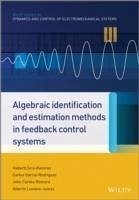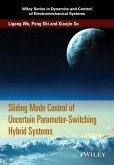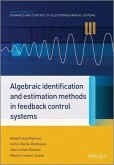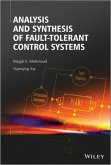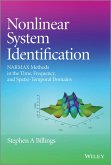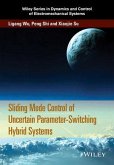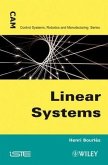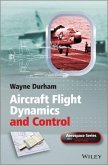Algebraic Identification and Estimation Methods in Feedback Control Systems (eBook, PDF)


Alle Infos zum eBook verschenken

Algebraic Identification and Estimation Methods in Feedback Control Systems (eBook, PDF)
- Format: PDF
- Merkliste
- Auf die Merkliste
- Bewerten Bewerten
- Teilen
- Produkt teilen
- Produkterinnerung
- Produkterinnerung

Hier können Sie sich einloggen

Bitte loggen Sie sich zunächst in Ihr Kundenkonto ein oder registrieren Sie sich bei bücher.de, um das eBook-Abo tolino select nutzen zu können.
Algebraic Identification and Estimation Methods in Feedback Control Systems presents a model-based algebraic approach to online parameter and state estimation in uncertain dynamic feedback control systems. This approach evades the mathematical intricacies of the traditional stochastic approach, proposing a direct model-based scheme with several easy-to-implement computational advantages. The approach can be used with continuous and discrete, linear and nonlinear, mono-variable and multi-variable systems. The estimators based on this approach are not of asymptotic nature, and do not require any…mehr
- Geräte: PC
- mit Kopierschutz
- eBook Hilfe
- Größe: 9.21MB
![Sliding Mode Control of Uncertain Parameter-Switching Hybrid Systems (eBook, PDF) Sliding Mode Control of Uncertain Parameter-Switching Hybrid Systems (eBook, PDF)]() Ligang WuSliding Mode Control of Uncertain Parameter-Switching Hybrid Systems (eBook, PDF)110,99 €
Ligang WuSliding Mode Control of Uncertain Parameter-Switching Hybrid Systems (eBook, PDF)110,99 €![Algebraic Identification and Estimation Methods in Feedback Control Systems (eBook, ePUB) Algebraic Identification and Estimation Methods in Feedback Control Systems (eBook, ePUB)]() Hebertt Sira-RamírezAlgebraic Identification and Estimation Methods in Feedback Control Systems (eBook, ePUB)110,99 €
Hebertt Sira-RamírezAlgebraic Identification and Estimation Methods in Feedback Control Systems (eBook, ePUB)110,99 €![Analysis and Synthesis of Fault-Tolerant Control Systems (eBook, PDF) Analysis and Synthesis of Fault-Tolerant Control Systems (eBook, PDF)]() Magdi S. MahmoudAnalysis and Synthesis of Fault-Tolerant Control Systems (eBook, PDF)110,99 €
Magdi S. MahmoudAnalysis and Synthesis of Fault-Tolerant Control Systems (eBook, PDF)110,99 €![Nonlinear System Identification (eBook, PDF) Nonlinear System Identification (eBook, PDF)]() Stephen A. BillingsNonlinear System Identification (eBook, PDF)117,99 €
Stephen A. BillingsNonlinear System Identification (eBook, PDF)117,99 €![Sliding Mode Control of Uncertain Parameter-Switching Hybrid Systems (eBook, ePUB) Sliding Mode Control of Uncertain Parameter-Switching Hybrid Systems (eBook, ePUB)]() Ligang WuSliding Mode Control of Uncertain Parameter-Switching Hybrid Systems (eBook, ePUB)110,99 €
Ligang WuSliding Mode Control of Uncertain Parameter-Switching Hybrid Systems (eBook, ePUB)110,99 €![Linear Systems (eBook, PDF) Linear Systems (eBook, PDF)]() Henri BourlèsLinear Systems (eBook, PDF)160,99 €
Henri BourlèsLinear Systems (eBook, PDF)160,99 €![Aircraft Flight Dynamics and Control (eBook, PDF) Aircraft Flight Dynamics and Control (eBook, PDF)]() Wayne DurhamAircraft Flight Dynamics and Control (eBook, PDF)85,99 €
Wayne DurhamAircraft Flight Dynamics and Control (eBook, PDF)85,99 €-
-
-
Dieser Download kann aus rechtlichen Gründen nur mit Rechnungsadresse in A, B, BG, CY, CZ, D, DK, EW, E, FIN, F, GR, HR, H, IRL, I, LT, L, LR, M, NL, PL, P, R, S, SLO, SK ausgeliefert werden.
- Produktdetails
- Verlag: John Wiley & Sons
- Seitenzahl: 392
- Erscheinungstermin: 13. März 2014
- Englisch
- ISBN-13: 9781118730577
- Artikelnr.: 40614809
- Verlag: John Wiley & Sons
- Seitenzahl: 392
- Erscheinungstermin: 13. März 2014
- Englisch
- ISBN-13: 9781118730577
- Artikelnr.: 40614809
- Herstellerkennzeichnung Die Herstellerinformationen sind derzeit nicht verfügbar.
Preface xv
1 Introduction 1
1.1 Feedback Control of Dynamic Systems 2
1.1.1 Feedback 2
1.1.2 Why Do We Need Feedback? 3
1.2 The Parameter Identification Problem 3
1.2.1 Identifying a System 4
1.3 A Brief Survey on Parameter Identification 4
1.4 The State Estimation Problem 5
1.4.1 Observers 6
1.4.2 Reconstructing the State via Time Derivative Estimation 7
1.5 Algebraic Methods in Control Theory: Differences from Existing
Methodologies 8
1.6 Outline of the Book 9
References 12
2 Algebraic Parameter Identification in Linear Systems 15
2.1 Introduction 15
2.1.1 The Parameter-Estimation Problem in Linear Systems 16
2.2 Introductory Examples 17
2.2.1 Dragging an Unknown Mass in Open Loop 17
2.2.2 A Perturbed First-Order System 24
2.2.3 The Visual Servoing Problem 30
2.2.4 Balancing of the Plane Rotor 35
2.2.5 On the Control of the Linear Motor 38
2.2.6 Double-Bridge Buck Converter 42
2.2.7 Closed-Loop Behavior 43
2.2.8 Control of an unknown variable gain motor 47
2.2.9 Identifying Classical Controller Parameters 50
2.3 A Case Study Introducing a "Sentinel" Criterion 53
2.3.1 A Suspension System Model 54
2.4 Remarks 67
References 68
3 Algebraic Parameter Identification in Nonlinear Systems 71
3.1 Introduction 71
3.2 Algebraic Parameter Identification for Nonlinear Systems 72
3.2.1 Controlling an Uncertain Pendulum 74
3.2.2 A Block-Driving Problem 80
3.2.3 The Fully Actuated Rigid Body 84
3.2.4 Parameter Identification Under Sliding Motions 90
3.2.5 Control of an Uncertain Inverted Pendulum Driven by a DC Motor 92
3.2.6 Identification and Control of a Convey Crane 96
3.2.7 Identification of a Magnetic Levitation System 103
3.3 An Alternative Construction of the System of Linear Equations 105
3.3.1 Genesio-Tesi Chaotic System 107
3.3.2 The Ueda Oscillator 108
3.3.3 Identification and Control of an Uncertain Brushless DC Motor 112
3.3.4 Parameter Identification and Self-tuned Control for the Inertia Wheel
Pendulum 119
3.3.5 Algebraic Parameter Identification for Induction Motors 128
3.3.6 A Criterion to Determine the Estimator Convergence: The Error Index
136
3.4 Remarks 141
References 141
4 Algebraic Parameter Identification in Discrete-Time Systems 145
4.1 Introduction 145
4.2 Algebraic Parameter Identification in Discrete-Time Systems 145
4.2.1 Main Purpose of the Chapter 146
4.2.2 Problem Formulation and Assumptions 147
4.2.3 An Introductory Example 148
4.2.4 Samuelson's Model of the National Economy 150
4.2.5 Heating of a Slab from Two Boundary Points 155
4.2.6 An Exact Backward Shift Reconstructor 157
4.3 A Nonlinear Filtering Scheme 160
4.3.1 Hénon System 161
4.3.2 A Hard Disk Drive 164
4.3.3 The Visual Servo Tracking Problem 166
4.3.4 A Shape Control Problem in a Rolling Mill 170
4.3.5 Algebraic Frequency Identification of a Sinusoidal Signal by Means of
Exact Discretization 175
4.4 Algebraic Identification in Fast-Sampled Linear Systems 178
4.4.1 The Delta-Operator Approach: A Theoretical Framework 179
4.4.2 Delta-Transform Properties 181
4.4.3 A DC Motor Example 181
4.5 Remarks 188
References 188
5 State and Parameter Estimation in Linear Systems 191
5.1 Introduction 191
5.1.1 Signal Time Derivation Through the "Algebraic Derivative Method" 192
5.1.2 Observability of Nonlinear Systems 192
5.2 Fast State Estimation 193
5.2.1 An Elementary Second-Order Example 193
5.2.2 An Elementary Third-Order Example 194
5.2.3 A Control System Example 198
5.2.4 Control of a Perturbed Third-Order System 201
5.2.5 A Sinusoid Estimation Problem 203
5.2.6 Identification of Gravitational Wave Parameters 205
5.2.7 A Power Electronics Example 210
5.2.8 A Hydraulic Press 213
5.2.9 Identification and Control of a Plotter 218
5.3 Recovering Chaotically Encrypted Signals 222
5.3.1 State Estimation for a Lorenz System 227
5.3.2 State Estimation for Chen's System 229
5.3.3 State Estimation for Chua's Circuit 231
5.3.4 State Estimation for Rossler's System 232
5.3.5 State Estimation for the Hysteretic Circuit 234
5.3.6 Simultaneous Chaotic Encoding-Decoding with Singularity Avoidance 239
5.3.7 Discussion 240
5.4 Remarks 241
References 242
6 Control of Nonlinear Systems via Output Feedback 245
6.1 Introduction 245
6.2 Time-Derivative Calculations 246
6.2.1 An Introductory Example 247
6.2.2 Identifying a Switching Input 253
6.3 The Nonlinear Systems Case 255
6.3.1 Control of a Synchronous Generator 256
6.3.2 Control of a Multi-variable Nonlinear System 261
6.3.3 Experimental Results on a Mechanical System 267
6.4 Remarks 278
References 279
7 Miscellaneous Applications 281
7.1 Introduction 281
7.1.1 The Separately Excited DC Motor 282
7.1.2 Justification of the ETEDPOF Controller 285
7.1.3 A Sensorless Scheme Based on Fast Adaptive Observation 287
7.1.4 Control of the Boost Converter 292
7.2 Alternative Elimination of Initial Conditions 298
7.2.1 A Bounded Exponential Function 299
7.2.2 Correspondence in the Frequency Domain 300
7.2.3 A System of Second Order 301
7.3 Other Functions of Time for Parameter Estimation 304
7.3.1 A Mechanical System Example 304
7.3.2 A Derivative Approach to Demodulation 310
7.3.3 Time Derivatives via Parameter Identification 312
7.3.4 Example 314
7.4 An Algebraic Denoising Scheme 318
7.4.1 Example 321
7.4.2 Numerical Results 322
7.5 Remarks 325
References 326
Appendix A Parameter Identification in Linear Continuous Systems: A Module
Approach 329
A.1 Generalities on Linear Systems Identification 329
A.1.1 Example 330
A.1.2 Some Definitions and Results 330
A.1.3 Linear Identifiability 331
A.1.4 Structured Perturbations 333
A.1.5 The Frequency Domain Alternative 337
References 338
Appendix B Parameter Identification in Linear Discrete Systems: A Module
Approach 339
B.1 A Short Review of Module Theory over Principal Ideal Rings 339
B.1.1 Systems 340
B.1.2 Perturbations 340
B.1.3 Dynamics and Input-Output Systems 341
B.1.4 Transfer Matrices 341
B.1.5 Identifiability 342
B.1.6 An Algebraic Setting for Identifiability 342
B.1.7 Linear identifiability of transfer functions 344
B.1.8 Linear Identification of Perturbed Systems 345
B.1.9 Persistent Trajectories 347
References 348
Appendix C Simultaneous State and Parameter Estimation: An Algebraic
Approach 349
C.1 Rings, Fields and Extensions 349
C.2 Nonlinear Systems 350
C.2.1 Differential Flatness 351
C.2.2 Observability and Identifiability 352
C.2.3 Observability 352
C.2.4 Identifiable Parameters 352
C.2.5 Determinable Variables 352
C.3 Numerical Differentiation 353
C.3.1 Polynomial Time Signals 353
C.3.2 Analytic Time Signals 353
C.3.3 Noisy Signals 354
References 354
Appendix D Generalized Proportional Integral Control 357
D.1 Generalities on GPI Control 357
D.2 Generalization to MIMO Linear Systems 365
References 368
Index 369
Preface xv
1 Introduction 1
1.1 Feedback Control of Dynamic Systems 2
1.1.1 Feedback 2
1.1.2 Why Do We Need Feedback? 3
1.2 The Parameter Identification Problem 3
1.2.1 Identifying a System 4
1.3 A Brief Survey on Parameter Identification 4
1.4 The State Estimation Problem 5
1.4.1 Observers 6
1.4.2 Reconstructing the State via Time Derivative Estimation 7
1.5 Algebraic Methods in Control Theory: Differences from Existing
Methodologies 8
1.6 Outline of the Book 9
References 12
2 Algebraic Parameter Identification in Linear Systems 15
2.1 Introduction 15
2.1.1 The Parameter-Estimation Problem in Linear Systems 16
2.2 Introductory Examples 17
2.2.1 Dragging an Unknown Mass in Open Loop 17
2.2.2 A Perturbed First-Order System 24
2.2.3 The Visual Servoing Problem 30
2.2.4 Balancing of the Plane Rotor 35
2.2.5 On the Control of the Linear Motor 38
2.2.6 Double-Bridge Buck Converter 42
2.2.7 Closed-Loop Behavior 43
2.2.8 Control of an unknown variable gain motor 47
2.2.9 Identifying Classical Controller Parameters 50
2.3 A Case Study Introducing a "Sentinel" Criterion 53
2.3.1 A Suspension System Model 54
2.4 Remarks 67
References 68
3 Algebraic Parameter Identification in Nonlinear Systems 71
3.1 Introduction 71
3.2 Algebraic Parameter Identification for Nonlinear Systems 72
3.2.1 Controlling an Uncertain Pendulum 74
3.2.2 A Block-Driving Problem 80
3.2.3 The Fully Actuated Rigid Body 84
3.2.4 Parameter Identification Under Sliding Motions 90
3.2.5 Control of an Uncertain Inverted Pendulum Driven by a DC Motor 92
3.2.6 Identification and Control of a Convey Crane 96
3.2.7 Identification of a Magnetic Levitation System 103
3.3 An Alternative Construction of the System of Linear Equations 105
3.3.1 Genesio-Tesi Chaotic System 107
3.3.2 The Ueda Oscillator 108
3.3.3 Identification and Control of an Uncertain Brushless DC Motor 112
3.3.4 Parameter Identification and Self-tuned Control for the Inertia Wheel
Pendulum 119
3.3.5 Algebraic Parameter Identification for Induction Motors 128
3.3.6 A Criterion to Determine the Estimator Convergence: The Error Index
136
3.4 Remarks 141
References 141
4 Algebraic Parameter Identification in Discrete-Time Systems 145
4.1 Introduction 145
4.2 Algebraic Parameter Identification in Discrete-Time Systems 145
4.2.1 Main Purpose of the Chapter 146
4.2.2 Problem Formulation and Assumptions 147
4.2.3 An Introductory Example 148
4.2.4 Samuelson's Model of the National Economy 150
4.2.5 Heating of a Slab from Two Boundary Points 155
4.2.6 An Exact Backward Shift Reconstructor 157
4.3 A Nonlinear Filtering Scheme 160
4.3.1 Hénon System 161
4.3.2 A Hard Disk Drive 164
4.3.3 The Visual Servo Tracking Problem 166
4.3.4 A Shape Control Problem in a Rolling Mill 170
4.3.5 Algebraic Frequency Identification of a Sinusoidal Signal by Means of
Exact Discretization 175
4.4 Algebraic Identification in Fast-Sampled Linear Systems 178
4.4.1 The Delta-Operator Approach: A Theoretical Framework 179
4.4.2 Delta-Transform Properties 181
4.4.3 A DC Motor Example 181
4.5 Remarks 188
References 188
5 State and Parameter Estimation in Linear Systems 191
5.1 Introduction 191
5.1.1 Signal Time Derivation Through the "Algebraic Derivative Method" 192
5.1.2 Observability of Nonlinear Systems 192
5.2 Fast State Estimation 193
5.2.1 An Elementary Second-Order Example 193
5.2.2 An Elementary Third-Order Example 194
5.2.3 A Control System Example 198
5.2.4 Control of a Perturbed Third-Order System 201
5.2.5 A Sinusoid Estimation Problem 203
5.2.6 Identification of Gravitational Wave Parameters 205
5.2.7 A Power Electronics Example 210
5.2.8 A Hydraulic Press 213
5.2.9 Identification and Control of a Plotter 218
5.3 Recovering Chaotically Encrypted Signals 222
5.3.1 State Estimation for a Lorenz System 227
5.3.2 State Estimation for Chen's System 229
5.3.3 State Estimation for Chua's Circuit 231
5.3.4 State Estimation for Rossler's System 232
5.3.5 State Estimation for the Hysteretic Circuit 234
5.3.6 Simultaneous Chaotic Encoding-Decoding with Singularity Avoidance 239
5.3.7 Discussion 240
5.4 Remarks 241
References 242
6 Control of Nonlinear Systems via Output Feedback 245
6.1 Introduction 245
6.2 Time-Derivative Calculations 246
6.2.1 An Introductory Example 247
6.2.2 Identifying a Switching Input 253
6.3 The Nonlinear Systems Case 255
6.3.1 Control of a Synchronous Generator 256
6.3.2 Control of a Multi-variable Nonlinear System 261
6.3.3 Experimental Results on a Mechanical System 267
6.4 Remarks 278
References 279
7 Miscellaneous Applications 281
7.1 Introduction 281
7.1.1 The Separately Excited DC Motor 282
7.1.2 Justification of the ETEDPOF Controller 285
7.1.3 A Sensorless Scheme Based on Fast Adaptive Observation 287
7.1.4 Control of the Boost Converter 292
7.2 Alternative Elimination of Initial Conditions 298
7.2.1 A Bounded Exponential Function 299
7.2.2 Correspondence in the Frequency Domain 300
7.2.3 A System of Second Order 301
7.3 Other Functions of Time for Parameter Estimation 304
7.3.1 A Mechanical System Example 304
7.3.2 A Derivative Approach to Demodulation 310
7.3.3 Time Derivatives via Parameter Identification 312
7.3.4 Example 314
7.4 An Algebraic Denoising Scheme 318
7.4.1 Example 321
7.4.2 Numerical Results 322
7.5 Remarks 325
References 326
Appendix A Parameter Identification in Linear Continuous Systems: A Module
Approach 329
A.1 Generalities on Linear Systems Identification 329
A.1.1 Example 330
A.1.2 Some Definitions and Results 330
A.1.3 Linear Identifiability 331
A.1.4 Structured Perturbations 333
A.1.5 The Frequency Domain Alternative 337
References 338
Appendix B Parameter Identification in Linear Discrete Systems: A Module
Approach 339
B.1 A Short Review of Module Theory over Principal Ideal Rings 339
B.1.1 Systems 340
B.1.2 Perturbations 340
B.1.3 Dynamics and Input-Output Systems 341
B.1.4 Transfer Matrices 341
B.1.5 Identifiability 342
B.1.6 An Algebraic Setting for Identifiability 342
B.1.7 Linear identifiability of transfer functions 344
B.1.8 Linear Identification of Perturbed Systems 345
B.1.9 Persistent Trajectories 347
References 348
Appendix C Simultaneous State and Parameter Estimation: An Algebraic
Approach 349
C.1 Rings, Fields and Extensions 349
C.2 Nonlinear Systems 350
C.2.1 Differential Flatness 351
C.2.2 Observability and Identifiability 352
C.2.3 Observability 352
C.2.4 Identifiable Parameters 352
C.2.5 Determinable Variables 352
C.3 Numerical Differentiation 353
C.3.1 Polynomial Time Signals 353
C.3.2 Analytic Time Signals 353
C.3.3 Noisy Signals 354
References 354
Appendix D Generalized Proportional Integral Control 357
D.1 Generalities on GPI Control 357
D.2 Generalization to MIMO Linear Systems 365
References 368
Index 369
